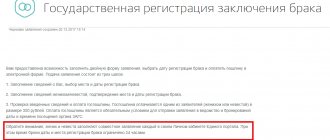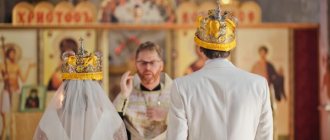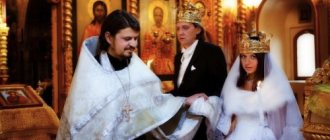RITE OF THE SACRAMENT OF WEDDING. PERMISSION OF THE CROWNS ON THE “EIGHTH DAY”
From the book of Herman Szymansky “Liturgics: Sacraments and Rites”
The ceremony of marriage should always be performed in church, and moreover, the most appropriate time for marriage is indicated to be the time after the liturgy.
Each marriage is supposed to be performed separately, and not several marriages together.
The rite of marriage consists of: 1) the rite of betrothal and 2) the sequence of wedding and resolution of crowns, i.e., the performance of the sacrament itself.
In the betrothal, “the word spoken by the spouses” is affirmed before God, that is, the mutual promise of the spouses, and as a pledge of this they are given rings; in the wedding, the union of the newlyweds is blessed and the grace of God is asked for them. In ancient times, betrothal was performed separately from wedding. Nowadays, a wedding usually follows immediately after an engagement.
The ceremony of betrothal. Before the betrothal, the priest places for consecration on the throne on the right side the rings (“rings”) of the newlyweds (one next to the other), while the silver one (which after the change goes to the groom) is placed on the throne on the right side of the gold one. The rings are placed on the throne as a sign that the union of the betrothed is sealed by the right hand of the Almighty and that the couple entrust their lives to the Providence of God.
For the betrothal, the priest, having put on the epitrachelion and phelonion, leaves the altar through the royal doors. He takes with him the cross and the Gospel in front of the lamp and places them on a lectern in the middle of the temple. The cross, the Gospel and the candle serve as signs of the invisible presence of Christ the Savior.
The betrothal takes place in the vestibule of the temple or at the very entrance to the temple (in the “entrance of the temple”).
The priest (three times) blesses the groom in a cross pattern, and then the bride with a lighted candle, which he then hands to everyone, showing that in marriage the light of the grace of the sacrament is taught and that for marriage a purity of life is necessary, shining with the light of virtue, why lighted candles are not given second marriage as no longer a virgin.
Then (according to the Rules) the priest censes them in the shape of a cross, indicating prayer and the teaching of the blessing of God, the symbol of which is incense, as a means of repelling everything hostile to the purity of marriage. (Currently, censing of the bride and groom before betrothal is not performed.)
After this, the priest makes the usual beginning: “Blessed is our God...” and pronounces a peaceful litany, which contains petitions for the spouses and for their salvation, for sending them perfect love and preserving them in unanimity and firm faith.
After the litany, the priest reads two prayers aloud, in which the betrothed asks for God’s blessing, unanimity, a peaceful and blameless life, etc. At the same time, the marriage of Isaac and Rebekah is remembered as an example of virginity and purity for the newlyweds. At this time, the deacon goes to the altar and brings rings from the throne.
The priest, having first taken the golden ring, overshadows the groom three times on his head, saying (three times):
“THE Servant of GOD (name) IS ENGAGED TO THE Servant of GOD (name) IN THE NAME OF THE FATHER AND THE SON AND THE HOLY SPIRIT, AMEN,”
and places the ring on the finger of his right hand (usually on the fourth finger).
In the same way, he hands over a silver ring to the bride, saying the words: “THE Servant of GOD (name) IS ENGAGED TO THE Servant of GOD...”.
After this, the rings are changed three times, and thus the bride’s ring remains as a pledge with the groom, and the groom’s ring remains with the bride.
By presenting the rings, the priest reminds the newlyweds of the eternity and continuity of their union. The subsequent three-fold change of rings indicates mutual consent, which must always exist between the spouses, and its completion by the successor or one of the relatives shows that the mutual consent of the spouses also includes the consent of their parents or relatives.
Having placed the rings on the right hands of the betrothed, the priest pronounces the betrothal prayer, in which he asks the Lord to bless and confirm the betrothal (Greek aеоа ona - pledge, cf. 2 Cor. 1, 22; 5, 5; Eph. 1, 14), like since He confirmed the betrothal of Isaac and Rebekah, blessed the position of the rings with a heavenly blessing, in accordance with the power shown by the ring in the person of Joseph, Daniel, Tamar and the prodigal son mentioned in the Gospel parable, confirmed the betrothed in faith, unanimity and love, and gave them an Angel Guardian all the days of their lives.
Finally, a short litany is pronounced: “Have mercy on us, O God...”, which happens at the beginning of Matins, with the addition of a petition for the betrothed. This ends the betrothal. Usually this is not followed by a dismissal, but a wedding.
Currently, according to the accepted custom, the priest proclaims: “Glory to Thee, our God, glory to Thee,” and while singing the 127th Psalm: “Blessed are all who fear the Lord,” enthusiastically depicting the blessings of a God-fearing family, getting married with lighted candles, preceded The priest is brought to a lectern placed in the middle of the temple with a cross and the Gospel. (According to the Rule, the psalm must be sung by the priest himself, and not by the deacon or singer, and to each verse of the psalm the people, and not just the singers, respond with the chorus: “Glory to Thee, our God, glory to Thee.” Such a performance of the psalm was a property of the ancient divine services of cathedral churches on the greatest holidays.)
The wedding sequence. Before the wedding begins, having brought the newlyweds before the lectern, the priest, according to the Charter, must explain to them what Christian marriage is as a sacrament and how to live in marriage pleasing to God and honestly.
Then he asks the bride and groom whether they have good, relaxed mutual consent and a strong intention to marry and whether they have promised to another person.
The question is: “Have you not promised another (or another)?” - proposed to the bride and groom, not only means whether he made a formal promise to marry another woman or to marry another, but also means: whether he entered into a relationship and illicit relationship with another woman or with another man, imposing certain moral and family responsibilities.
After a positive response from the spouses about their voluntary entry into marriage, a wedding is performed, consisting of a great litany, prayers, laying of crowns, reading the word of God, drinking a common cup and walking around the lectern.
The deacon exclaims: “Bless, master.”
The priest makes the initial exclamation: “Blessed is the Kingdom,” and the deacon pronounces a peaceful litany, in which petitions are attached for the spouses, for their salvation, for the granting of chastity to them, for the birth of sons and daughters from them, and for God’s protection for them all the days of their lives.
After the litany, the priest reads three prayers for those marrying, in which he asks the Lord to bless the present marriage, just as He blessed the marriages of the Old Testament righteous - to grant the couple peace, long life, chastity and love for each other, and to make them worthy to see their children and fulfill their home. their wheat, wine and oil.
At the end of the prayers, the priest, having accepted the crowns, alternately crosses the bride and groom with them (letting them kiss the crown itself) and places them on their heads as a sign and reward of their preserved purity and chastity until marriage, as well as as a sign of marital union and power over future offspring .
At the same time, the priest says to each of the spouses:
“THE Servant of GOD (name) IS MARRIED TO THE Servant of GOD (name)” or “THE Servant of GOD (name) IS MARRIED TO THE Servant of GOD (name), IN THE NAME OF THE FATHER AND THE SON AND THE HOLY SPIRIT.”
After laying the crowns, the priest blesses the bride and groom three times together with the usual priestly blessing, saying:
“Lord our God, crown (them) with glory and honor.”
This laying of crowns and prayers (during the laying of crowns) - “The servant of God is crowned... the servant of God” and “Lord our God, crown me with glory and honor” - are recognized in theology as perfect, i.e. constituting the main moment of the sacrament of Marriage and imprinting it, which is why the very sequence of the sacred rite is called a wedding.
Then the prokeimenon is pronounced: “Thou hast placed crowns on their heads,” and after the prokeimenon the Apostle and the Gospel are read, of which the first (Eph. 5:20-33) reveals the teaching about the essence and height of Christian marriage, the duties of husband and wife, and shows the original
the establishment and celebration of marriage, and in the second (John 2,
1-11) - the story of Jesus Christ’s visit to a marriage in Cana of Galilee and the transformation of water into wine there shows the godly nature of Christian marriage and the presence of God’s blessing and grace in it.
After reading the Gospel, the litany is pronounced: “Everyone sings,” and after an exclamation - a prayer for the newlyweds, in which they ask the Lord for peace and unanimity, purity and integrity, the achievement of venerable old age and continuous observance of the commandments of God.
The prayer for those getting married consists of a petitionary litany for all believers (with its ancient beginning from the petition “Intercede, save”) and the singing of the Lord’s Prayer, uniting the hearts of all in one spirit of prayer, so that in this way the very triumph of marriage would be elevated and the outpouring of grace would increase not only on those who were married marriage, but also for all believers. This is followed by the teaching of peace and the prayer of adoration.
After this, a “common cup” of wine is brought, in remembrance of how the Lord blessed wine at the wedding in Cana of Galilee; the priest blesses it with prayer and teaches it three times to the newlyweds in turn. Wine is served to the bride and groom from a common cup as a sign that they must live in an inextricable union and share the cup of joys and sorrows, happiness and misfortune.
Having presented the common cup, the priest joins the right hands of the newlyweds, covering them with stole, as if tying their hands before God, thereby signifying their union in Christ, as well as the fact that the husband, through the hands of the priest, receives a wife from the Church itself, and circles the newlyweds three times around the lectern , on which lie the cross and the Gospel. This walking in a circle generally signifies the spiritual joy and triumph of the couple (and the Church) about the sacrament being performed and the expression of their firm vow, given before the Church, to eternally and faithfully preserve their marital union. The circumambulation is performed three times - to the glory of the Holy Trinity, which is thus invoked as a witness to the vow.
During the circumambulation, three troparions are sung. In the first of them: “Isaiah, rejoice...” - the incarnation of the Son of God, His birth from the most blessed Virgin Mary is glorified and thus solemnly reminded of the Divine blessing of childbearing.
In the second troparion: “Holy Martyr...” - the ascetics and martyrs are glorified and called to pray for us, along with whom the married couple seems to be included as having overcome temptation, preserved chastity and now set out for the feat of life in marriage. Following their example, newlyweds are encouraged to overcome all the devil's temptations in their lives in order to be rewarded with heavenly crowns.
Finally, in the third troparion: “Glory to Thee, O Christ our God,” Christ is glorified as the praise of the apostles and the joy of the martyrs, and together the joy and glory of the newlyweds, their hope and help in all circumstances of life.
After circumambulating three times, the priest removes the crowns from the newlyweds and at the same time says special greetings to each of them, in which he wishes them exaltation from God, joy, multiplication of offspring and keeping the commandments. Then he reads two prayers in which he asks God to bless those married and send them earthly and heavenly blessings.
According to accepted practice, after this a prayer is read for the permission of the crowns “on the eighth day.” And there is a vacation.
This is usually followed by a celebration of many years, sometimes preceded by a short prayer service, and congratulations to the newlyweds.
PERMISSION OF CROWNS “ON THE EIGHTH DAY”
In the Trebnik, after the wedding rite, there is a “Prayer for the permission of crowns, on the eighth day.” In ancient times, those who married wore crowns for seven days, and on the eighth day they laid them down with the prayer of the priest. Crowns in ancient times were not metal, but simple wreaths made of myrtle or olive leaves, or some other non-withering plant. Currently, the prayer for the permission of crowns is read before the dismissal of the wedding.
Use of photographs is possible with the personal permission of the author.
Number of views - 1135










